On the last Saturday of July 2023, several members of the DVHSG met at the Salem County Historical Society for the dedication of the Sarah Thompson, 1775 Sampler.

The Conservation Committee set out to find the perfect sampler to conserve in honor of one of our founding members, Patti Hrynenko. Patti was a great asset to the south Jersey sampler world.
Her love of historic needlework started long before the guild. Patti had a long-term affiliation with the Gloucester County Historical Society where she dedicated her efforts to seeing that their collection of samplers did not remain in storage. She spent countless hours researching the girls who stitched these samplers and was able to tell a story about each one. She has charted several of them with the proceeds from sales benefitting the Society's Sampler Collection Designated Fund to b used for the continued preservation of samplers in their collection.The first sampler she charted was Lucy Hugg, in 1999. This same sampler would become the Guild's first stitch-along. There are six samplers available on the Gloucester County Historical Society website. Many of us enjoyed the tours she lead at the Gloucester County Historical Society.
Nine of the pieces in the Society's collection were included in the 2014-15 New Jersey Sampler exhibit at the Morven Museum, and can be seen in the exhibit catalog- "Hail Specimen of Female Art". The 1788 Sybil Tatum Quaker medallion catalog- "Hail Specimen of Female Art". The 1788 Sybil Tatum Quaker medallion sampler was included in Carol Humphrey's book, "Quaker School Girl Samplers from Ackworth".
Patti's contributions to our Guild over the years were many, including private tours of the Gloucester County sampler collection and other textile exhibits. A favorite memory is the fabulous talk she gave when we celebrated the Guild’s 20th Anniversary in 2022 - delayed for two years because of Covid. It was full of history for the new members and fun memories for the veteran members.
Sarah Thompson Sampler, age 10, 1775
Many thanks for the Conservation Committee for their work and to Marnie B. for the wonderful tribute she made, part of which I used to create my comments above.
Those who attended the dedication had a chance to tour the museum while there.
 The museum is located in the Alexander Grant home, erected in 1721, with portions erected in 1690. The building itself has a lot of history. In addition to being a family home, it once was a temperance hotel and also medical offices. In 1850, John S. Rock, studied dentistry here. Mr. Rock was the first African-American attorney admitted to practice law before the U. S. Supreme Court.
The museum is located in the Alexander Grant home, erected in 1721, with portions erected in 1690. The building itself has a lot of history. In addition to being a family home, it once was a temperance hotel and also medical offices. In 1850, John S. Rock, studied dentistry here. Mr. Rock was the first African-American attorney admitted to practice law before the U. S. Supreme Court.
Above, the Alexander Grants House, Col. Robert Gibbon Johnson, 1821 and the Salem Oak - all from the Cat’s Meow Collection of Salem County
Directly across the street from the museum are the courthouse steps where Col. Johnson took a bite out of a “love apple” or tomato and did not die!
SALEM OAK This area is rich in history and the Salem Oak is part of that history. This large oak tree is the site where John Fenwick signed a treaty with the Lenni Lenape Indians in 1675 when he arrived and founded Salem, NJ. The oak was over 600 years old. It is believed to be part of the original forest that was part of John Fenwick’s land. It measured 22 feet in circumference and stood over 100 feet tall with a span of over 104 feet. It was located in the Salem Friends Burial Ground in Salem NJ, before is just fell over one day in June of 2019. Before that it was one of NJ best-known trees and ranked among the largest white oak’s on NJ.
Other notable history for Salem County is that Betsy Ross used to summer in Mannington, NJ just a few miles from the Alexander Grant House.
The chair below it believed to have belonged to William Penn. Although mainly associated with Philadelphia and Pennsylvania, William Penn had many ties to Salem County. The chair was brought from Philadelphia in the 1870’s by Jesse Bond, a respected Quaker School Teacher. His family were friends of the Penn Family.
 For a small historical society, there had a lovely collection of 30 to 35 samplers.
For a small historical society, there had a lovely collection of 30 to 35 samplers.
Another early sampler from the collection is this alphabet sampler. It is signed “EB”. The stitcher is unknown. The sampler is dated 1793.
This lovely sewing stand was located in the sampler room.
Mary Tyler, Westtown Sampler, 1820

Elizabeth Fogg sampler, 1846
Eliza Gamble, 1848 Sampler
Sampler and painting.
Elizabeth Goodwin, a Westtown Sampler, 1820
Hannah Abbott sampler
Mary Jane Williams, 1840’s
Lydia Fogg, 1835
Peyote bag, undated
Margaret Denn, 1829
GLASS WARE
Salem County was the ‘cradle of glass” in America. Casper Wistar, from Philadelphia, started a glass factory in Alloway in 1738. They produced window panes, bottles and other glass containers for the next 40 years. In the mid-19th century the local industry employee 24,000 employees. (2023 census puts the current population of the county at 65,000). Operating several glass factories: Wistarburg Glass, Gaynor Glass Works via Holtz, Clark & Taylor, Salem Glass Works, Quinton and Elmer Glass works as well as Anchor Hocking.
Large scale production of glass is no longer done in Salem, however, Salem Community College offers degrees in glass blowing a glass artistry at a much lower cost than it’s rivals of Rhode Island School of Design and Tulane University and provides the nation’s only degree program in scientific glass blowing.
Samples of glass from the Wistarburg Glass Works

Canton China, from the Port of Canton, China. Imported for 400 years, up to the 1940’s. Collection of local resident donated to the historical society.
On the lower shelf, silver sugar tongs from the early 19th century by local silversmith Charles Ramsey.
What a crazy claim to fame….glass coffins!?
NOBEL PRIZE WINNER
More 20th century history is Salem had its very own Nobel Peace prize winner. Mr. Charles J. Petersen was awarded Ed the Nobel Prize in Chemistry in 1987. He won jointly with Donald J. Cramer and Jean-Marie Leon for “their development and use of molecules with structure-special interaction of high selectivity.”

Madame Duval’s Cameo Collection.
Local resident, Sarah Hancock Sinnickson was the daughter of Judge Willam Hancock. Killed in the Hancocks Bridge massacre, March 21, 1778. She was married to Captain Thomas Sinninckson of the Caleb County militia. During the Revolutionary War, her home was occupied by the British and her husband forced to serve or suffer imprisonment and lost of land and all property. The dress below is the dress Sarah wore to the inaugural ball for George Washington as President.
QUILTS
Outstanding “crazy quilt”. Also known as the Lafayette Quilt, 1890. It is called the Lafayette Quilt because there is fabric from Revolutionary War General Lafayette’s sash in the quilt.
This museum packed a lot into its humble space and much more than I have shared here. Soon to open is a room that will be dedicated to all things children - toys, beds, clothing, etc.
 The museum is located in the Alexander Grant home, erected in 1721, with portions erected in 1690. The building itself has a lot of history. In addition to being a family home, it once was a temperance hotel and also medical offices. In 1850, John S. Rock, studied dentistry here. Mr. Rock was the first African-American attorney admitted to practice law before the U. S. Supreme Court.
The museum is located in the Alexander Grant home, erected in 1721, with portions erected in 1690. The building itself has a lot of history. In addition to being a family home, it once was a temperance hotel and also medical offices. In 1850, John S. Rock, studied dentistry here. Mr. Rock was the first African-American attorney admitted to practice law before the U. S. Supreme Court. 





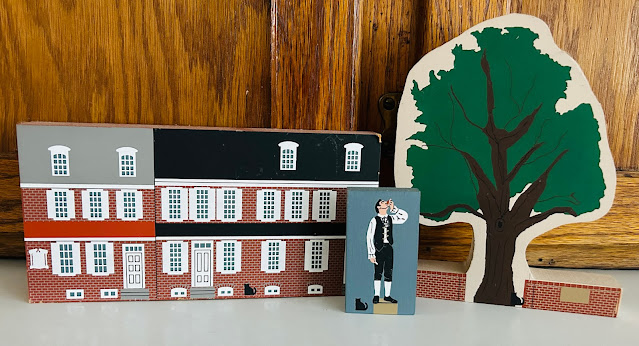

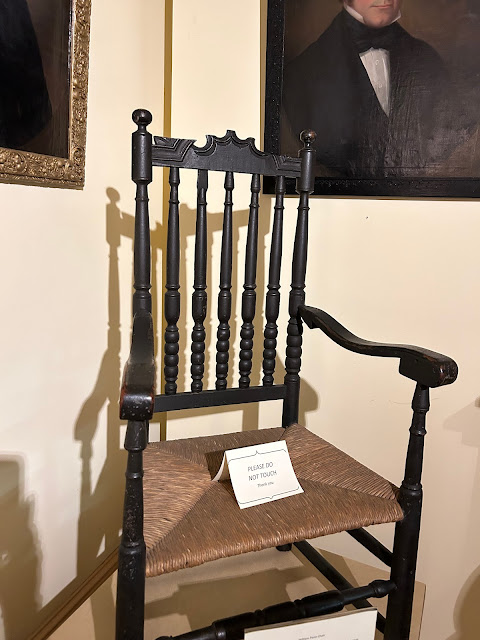










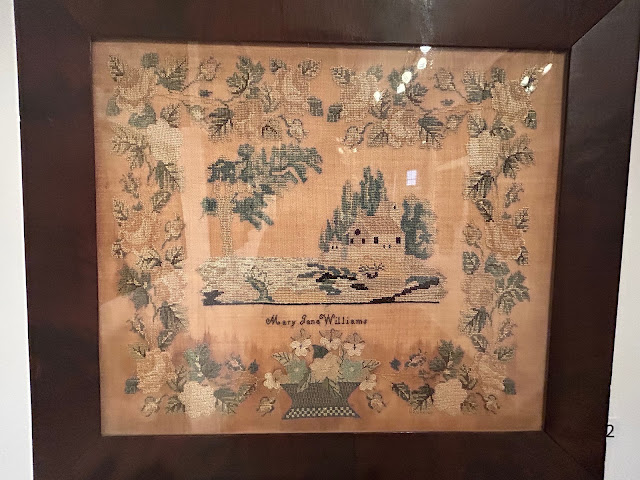
















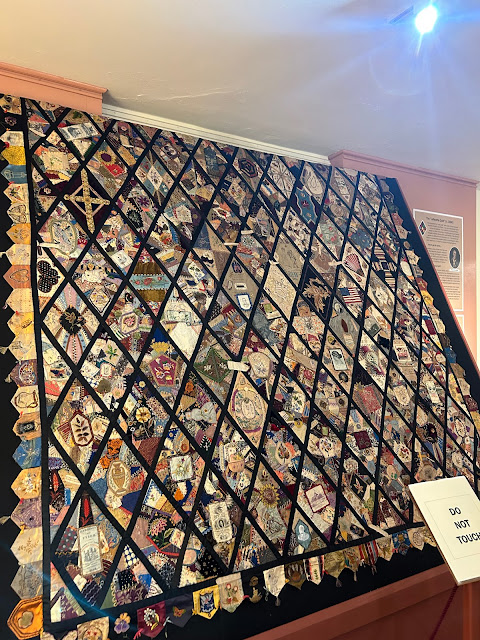


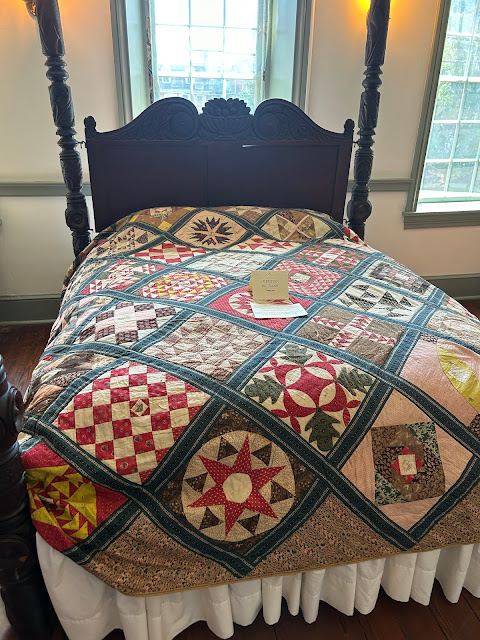




No comments:
Post a Comment